Nearly eight decades ago, Soviet women fighter pilots proved they could be the Top Guns of their day.
We live in a time when shockingly regressive views can gain traction and popularity. Case in point: apparently some people aren’t convinced that women can fly planes. That deserves a “well, actually:” women have been involved with powered flight since the very beginning.
While pioneering early aviators like Amelia Earhart may have seemed like novelties or aberrations, that changed with World War II. Just as it was a time for women to prove in large numbers they could do “a man’s job” in science and industry, this was also when women proved they could fly planes just as well. Air forces on all sides employed women as test pilots and to ferry new planes to the front lines. Moreover, in the Soviet Union, women pilots were put to the ultimate test in combat.
Due to the Cold War, the contribution of Soviet women combat pilots was little known in the West. Thankfully, more and more, their history is coming to light. Most of the attention goes to the “Night Witches,” an all-female regiment of bomber pilots. Flying their antiquated biplanes in the dead of night, they are a plucky underdog story. But arguably more amazing is the fact that the Soviet Union also entrusted women with the most expensive and technologically advanced hardware the Motherland had to offer: fighter planes.
This is the story of Soviet women fighter pilots of World War II.
Youth to the Airplanes
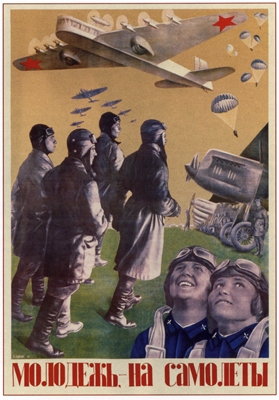
The Russian Revolution of 1917 was not only supposed to herald in an of progress for the working class. It was also supposed to usher in equality among races and genders. Women were encouraged to seek roles in all facets of the working world.
Stalin’s rise in the 1920s saw a retrenchment in this view. Women were once again pigeonholed in a primarily domestic role. However, this attitude competed with the real need to rapidly industrialize and modernize the Soviet Union. War with the capitalist world was thought to be inevitable, so it was all hands on deck in the drive to prepare the nation’s modern military force.
Women were among the most enthusiastic adherents of modernization. Nothing epitomized modernity more than aviation. In the 1920s and 1930s, airborne explorer were on par with movie stars for fame. When the Komsomol (Communist Youth League) partnered with the paramilitary organization charged with preparing future military personnel to set up flying clubs across the country, thousands of young people signed up. In all, an estimated 140 aeroclubs trained around 150,000 pilots in the 1930s, a third of them women. Many of these women progressed to become flight instructors. In the years leading up to World War II, it was quite common for future Air Force pilots to have been trained by women.
A Call to Arms
On June 22, 1941, Nazi Germany invaded the Soviet Union. Almost immediately, huge numbers of volunteers, young and old, joined the war effort. Thousands of women attempted to sign up for combat duty but were turned away.
| The Three Winged Sisters
In 1938, Marina Raskova, Polina Osipenko and Valentina Grizudubova set out to fly from Moscow to the Pacific across Siberia. They crash landed short of their goal, due to poor visibility. Raskova was separated from the others and survived for 10 days in the wild. When all three were rescued, it was confirmed that they’d set a record for longest flight by a female pilot. |
Within weeks, the Germans had conquered huge swathes of Soviet territory. The invaders utterly decimated the Soviet Air Force, destroying thousands of planes and killing thousands of pilots and ground crew. In desperation, the defenders often threw new pilots into action with as little as 10-15 hours of flight time. The many skilled and experienced women pilots were frustrated to be held back from combat when they were needed the most.
Then in October 1941, as the Germans approached the gates of Moscow, an order from Stalin himself authorized the creation of three women’s air force regiments. The driving force behind this was the famous aviatrix Marina Raskova, one of the “Three Winged Sisters.” She would personally select several hundred volunteers from the applicants. Already a navigation instructor at the Air Force Academy, she would also lead the training and eventually command one of the regiments.
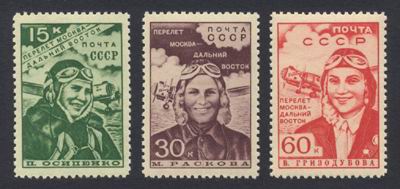
The Best of the Best
Shortly after the recruits were assembled in Moscow in October 1941, they evacuated along with much of the city to escape the oncoming German onslaught. While Moscow held out through the winter of 1941-42, the women trained at an air force base in Engels, on the River Volga, 700 km to the southeast.
The recruits included pilots, navigators and technicians, all the personnel required for fully functioning air force regiments. While all the pilots wanted to fly fighters, only the top 25 were selected for this duty. The other pilots were assigned to fly dive bombers and night bombers.
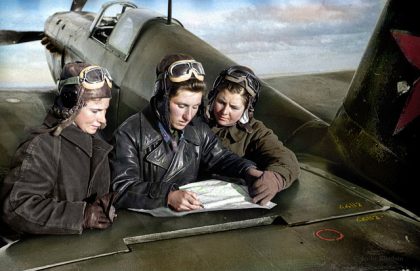
The 587th Bomber Aviation Regiment would be personally led by Raskova. They flew the Pe-2 dive bomber throughout the war. Raskova herself would die in the line of duty, crashing in a snowstorm in January 1943. The regiment gained a male commander and integrated male personnel. They would continue to fight on the front lines, flying 1,134 missions and dropping over 980,000 tons of bombs on the enemy.
The 588th Night Bomber Regiment flew outdated U-2 (Po-2) biplanes. Their job was to fly at night over enemy encampments dropping bombs to harass and terrorize them as they slept. This earned them one of the most awesome nicknames of the war: Nacht Hexen (Night Witches.) Their courage was legendary. They were highly vulnerable to enemy ground fire and aircraft. 24 members of the regiment earned their nation’s highest honour, Hero of the Soviet Union.
The 586th Fighter Aviation Regiment
Originally intended to be sent to defend the skies over Moscow, the women fighter pilots were reassigned to defend the industrial centre of Saratov, as the Germans shifted their focus to the south. On September 24, 1942, Valeria Khomyakova became the first woman in history to shoot down an enemy aircraft. In April 1943, two pilots took on forty-two German bombers by themselves, shooting down four. The incident was mentioned in dispatches by a British correspondent in Russia. Word reached King George VI of England, who was so impressed he sent the pair, Raisa Surnachevskaya and Tamara Pamyatnykh, two commemorative gold watches.
Despite these achievements, the 586th’s war efforts remain largely overlooked. It’s likely this was due to treacherous Soviet politics as much as anything else. The first commander was Tamara Kazarinova. An ardent communist, Kazarinova had been wounded earlier in the war and as a result, she didn’t fly planes for the regiment she commanded. She also clashed with many of the pilots, who displayed the brashness and independent streaks one might expect from “top guns.”
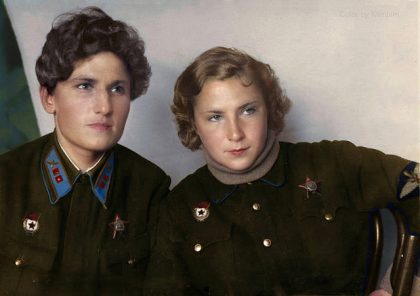
In September 1942, as the Soviet Union desperately hung on in the city of Stalingrad, eight supposed troublemakers were transferred to units on the frontline there. That didn’t end Kazarinova’s troubles and she was removed from command. Like Raskova, her replacement was a man, Alexander Gridnev. Male pilots and crews also integrated into the regiment. Gridnev was a survivor of Stalin’s purges, and so had a “black mark” on his record. Other male pilots sent to the regiment were also considered politically troublesome. Kazarinova still had powerful friends, and it seems the regiment was withheld from honours. They spent the war on air defence duties, set back from the front lines.
Even with the lack of political support and flying in air defence, the regiment took part in their fair share of battles. They flew 4,419 combat sorties and took part in 125 air battles, downing 38 enemy aircraft. At least 10 of their number, nearly a third of the fighter pilots, were killed during the war.
Legend of the White Rose
The eight rebellious pilots sent to Stalingrad were split up across two separate male fighter regiments. At first, their new comrades were reluctant to take them on. The women had to beg every day to be given a chance to fly, even as casualties thinned out the ranks. Eventually, their persistence paid off. Lidya Litvyak and Katya Budanova started making names for themselves, shooting down several aircraft. The women also suffered their first casualty, as Klavdiya Nechayeva was killed covering for her commander when they were attacked while landing.
Sometime during the Battle of Staligrad, Litvyak was acknowledged as the world’s first female fighter ace, having shot down five enemy aircraft. One of the first enemy pilots she down was an ace, who demanded to meet the victor. When he met the petite blonde Litvyak, he thought it was a joke, until she reenacted the events of their battle.
The Soviets turned the tide of battle at Stalingrad, trapping an entire German army in the city. As the Luftwaffe tried to resupply their compatriots from the air, special “free hunters” were assigned to shoot down the transports and any other enemy planes they encountered on their way. These were the considered to be the elite among fighter pilots, and Livyak and Budanova were selected to join them. Legend has it that Litvyak painted a white lily (in Russian, her diminutive name “Lilya” means lily) on the side of her plane. This led to her misnomer in some Western books written about her: The White Rose of Stalingrad.
A Storm of Steel
After Stalingrad, the commander of the Air Force ordered the women fighter pilots to return to the 586th. While three pilots complied, Litvyak and Budanova, along with Antonina Lebedeva and Klavdiya Blinova, applied to be replacement pilots with other male regiments.
| The Mystery of Lidya Litvyak
Controversy persists to this day about Litvyak’s fate. Although the official record now says that she was killed in battle, there have been reports that she either crash landed or bailed out safely. Some Soviet POWs report seeing her captured by the Germans. Apparently, a Swiss television program interviewed a former Soviet female fighter pilot who may have been Litvyak in 2000. She had been shot down and captured. After the war, fearing Soviet reprisals against former prisoners, she stayed in the West and married, having three children. |
Litvyak and Budanova continued fighting on the front lines. In all, Litvyak was credited with shooting down twelve enemy aircraft, while Budanova scored eleven “kills.” Friends and comrades, both were shot down within a couple of weeks during the furious fighting in the summer of 1943. They were reported as missing in action. The Soviet Union treated any missing military personnel as potential traitors. Because of this, the government denied any honours due to either of them. In 1979, the remains of a pilot and aircraft were identified as Litvyak’s. In 1988, reports surfaced of a female pilot matching Budanova who farmers found dead after crash landing, then burying her remains. Both pilots were finally given their nation’s highest honour in the 1990s.
Lebedeva and Blinova fought in a different regiment from the other two. They took part in the pivotal Battle of Kursk in July 1943. The intensity of the combat exceeded anything experienced at Stalingrad. At its height, pilots flew five to six missions daily, frequently engaging in combat. A veritable storm of steel, veterans describe a sky filled with dogfighting airplanes, tracer streaks, flames and smoke. Nearly every day ended with a comrade in the regiment dead. Lebedeva was shot down during the battle, burning to death in her fighter.
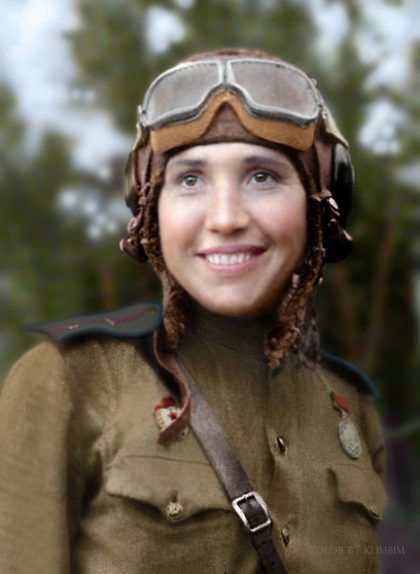
Blinova was also shot down in August 1943. She was captured by Germans and put on a train to a concentration camp to the west. Along with several other pilots, she managed to unfasten the latch to their freight car and escape into the forest. They survived for two weeks in the wild before making it back to Soviet lines. After internment and questioning by the Soviet security forces, she was finally released back to her regiment and flew with them through the conquest of Berlin and victory. She later married a fellow pilot from the regiment and worked in commercial aviation after the war.
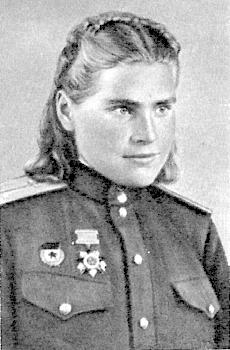
After the War
Soviet women fighter pilots often had to make sacrifices over and above the men. Few concessions were made for female clothing or sanitary supplies. Like other servicewomen, they were in danger of sexual misconduct and assault from their own side. Life was difficult for them after the war as well. Many were shunned in society, labelled as “unwomanly,” “homewreckers” and “whores.” They were even denied the right to march in the victory parade.
For years, the official history of the Soviet Union sought to minimize the contributions of women combatants during the war. The women’s fighter regiment suffered neglect in particular. Although this was partly due to its more limited role in air defence, the political troubles of its commanders had much to do with this. Even as the story of women pilots is exposed more in the West, the fighter pilots are often overshadowed by the more famous Night Witches.
Flying fighter planes pushes the limits of human combat abilities. Fighter pilots endure enormous g-forces, need to make split-second decisions and test their wits against tenacious and determined foes. The achievements of Soviet women fighter pilots in World War II prove beyond a doubt that women can indeed fly planes as well as men.
Sparrow Squadron
Soviet women fighter pilots take centre stage in the YA novel Sparrow Squadron. Although fiction, it follows the story of Aelya Makarova, whose experience is similar to that of the women of the 586th who were sent to the Battle of Stalingrad. While the novel ends there, future installments will continue as the war progresses.
Read a preview here.
Further Reading
Wings, Women, and War: Soviet Airwomen in World War II Combat, by Reina Pennington
A Dance with Death: Soviet Airwomen in World War II, by Anne Noggle
Soviet Airwomen, by Gian P. Milanetti
Soviet Women on the Frontline in the Second World War, by Roger Markwick
Russian Aviation and Air Power in the Twentieth Century, edited by Robin Higham, John T. Greenwood and Von Hardesty

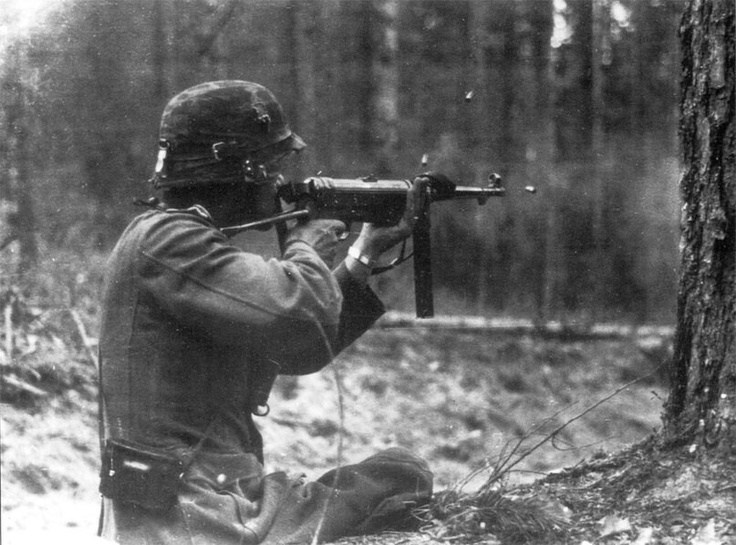
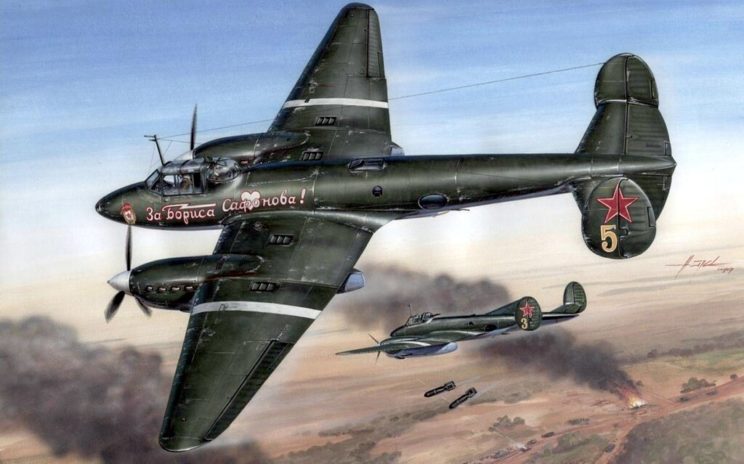
One thought on “Deadly Skies: Soviet Women Fighter Pilots of WWII”